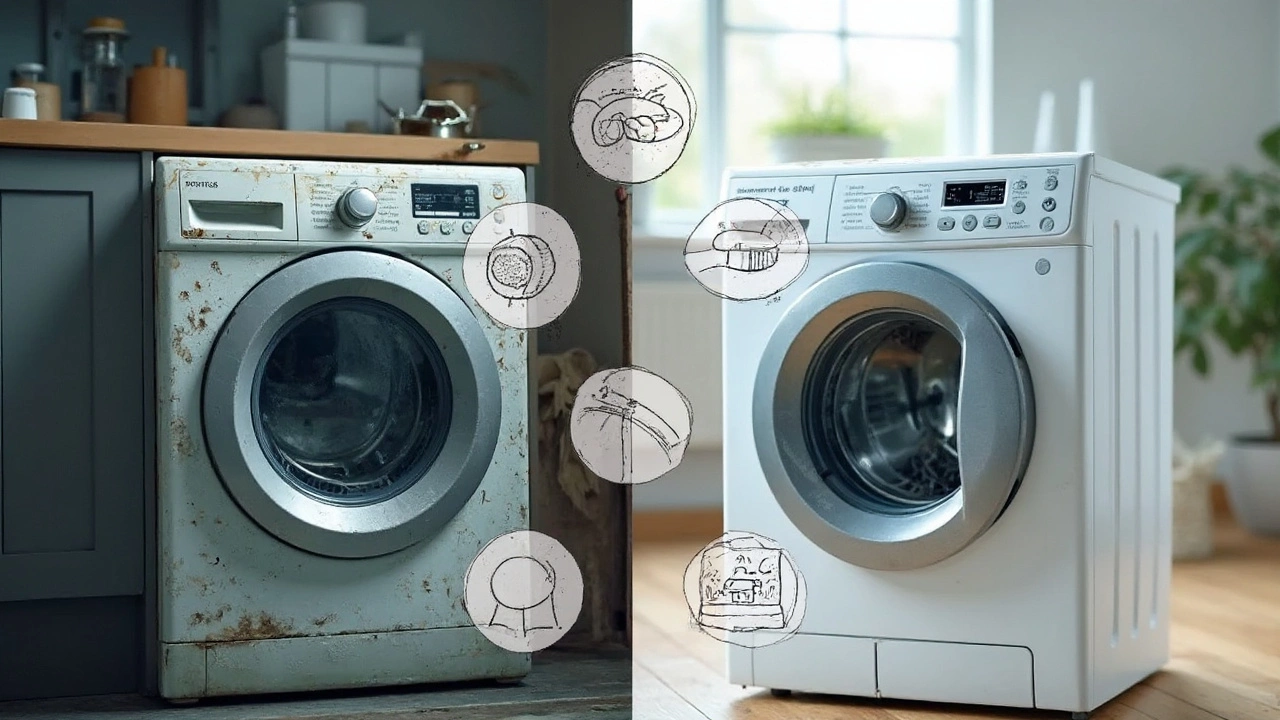The sound of an off-balance spin cycle echoes through the house, and suddenly your 7-year-old washing machine starts throwing a tantrum. One day you’re tossing in muddy soccer uniforms, the next you’re asking Google if fixing this thing is even worth it. It’s not a small question for any family. Nobody wants to spend big money unless it really makes sense. So what do you do when your washing machine hits seven and starts acting up?
How Long Do Washing Machines Really Last? The Age and Value Question
Time passes faster than you’d think for home appliances. Brands like Whirlpool, LG, and Maytag actually expect their washing machines to last 8-12 years. But here’s the thing: that’s an average. Some machines limp along at seventeen, others start leaking at five. Your own family’s laundry habits, the type of detergent you use, and even how much you jam into the drum will affect how long it goes before things go haywire.
The seven-year mark is like middle age for a washer. Consumer Reports did surveys showing most washers face their first big repairs around year five to seven. After ten years, a lot of them get sent packing. But if a machine’s still got its original motor and the inside isn’t rusting to pieces, there could be life left in it.
Here’s a quick look at average lifespans of common washing machine brands:
| Brand | Average Lifespan (Years) |
|---|---|
| Whirlpool | 10-12 |
| Samsung | 8-12 |
| LG | 10-13 |
| GE | 8-10 |
| Maytag | 11-14 |
So a seven-year-old washer could be on the back half of its journey, or it might have a few good years left. Maintenance habits, lucky breaks with parts, and how hard you run it all shape whether repairs make sense. When you’re tight on cash, a couple hundred bucks for a repair may sound a lot better than dropping over a grand on a new model. The flip side? Sometimes, a repair is just tossing money into a dying machine. Knowing where that line sits—the ‘repair or replace’ cutoff—is what saves you headaches and cash.

What’s Broken? Common 7-Year Washer Problems and True Costs
Once you hit the seven-year mark, washer breakdowns often fall into the same bucket of issues. These aren’t the quick fixes like resetting an error code—they tend to need real replacement parts or a pro’s visit. These are the top hiccups people run into:
- Drum won’t spin or drains slowly (worn-out motor, bad belt, or blocked drain pump)
- Noisy cycles or grinding sounds (bearings, shocks, shocks/pads, or foreign objects)
- Water leaking on the floor (failed hoses, water pump, door seal)
- Electronic errors or won’t power on (faulty control board, broken start button or switches)
- Strange smells or mold (gasket mildew, or poor drainage)
The first step is running a quick self-diagnosis. If you hear the motor but the drum just sits there, a snapped belt or seized bearing is likely. Water on the floor probably means leaks or failed hoses rather than something electronic. Honestly, YouTube is loaded with videos for every DIY fix you can imagine. (Ever watched a dad in pajamas swap out a washer pump? It’s the most real Saturday ever.)
Here’s where the real numbers start: actual repair costs. Expect to pay more for high-efficiency front loaders compared to the old school top-loaders—they’re more complicated inside. According to HomeAdvisor data from 2025, average repair jobs for common washer problems look like this:
| Repair Type | Estimated Cost (USD) |
|---|---|
| Drain Pump Replacement | 150 - 250 |
| Drive Belt Repair | 80 - 200 |
| Electronic Control Board | 200 - 450 |
| Water Inlet Valve | 120 - 230 |
| Bearing Replacement | 300 - 500 |
| Door Seal/Gasket | 140 - 275 |
Here’s the kicker: if your repair bill is close to 50% the cost of a new washer, that’s usually where people tap out and buy new. Major parts like the drum or the control board? Once those go, your old washer basically turns into a money pit. If it’s just a small leak or a belt and the rest of the machine is fine, fixing makes sense. If you’ve been seeing one thing after another fail—first a pump, then a board, then a gasket—you’re betting against the odds every time you call the repair tech.
Ask yourself: has this machine needed more than one big repair already? Have you spent more than $250 in repairs so far? If “yes” on both, it’s pointing toward replacement time. Most new washers made after 2020 are noticeably more energy and water efficient, so buying new could slash your energy bills and save you money down the road. On the other hand, a well-cared for old washer can sometimes outlast newer models, especially if you’re good at keeping the drum and gaskets clean.

Making the Call: Fix It, DIY, or Move On?
This is the part where you break out that classic napkin math and really weigh your options. Don’t forget to include hidden costs: things like time waiting for a repair tech, lost laundry days, and the joys of hand-washing socks in the bathtub. Here’s a checklist to make it easier if your *washing machine repair* decision still feels foggy:
- Age of your machine—Is it under 8 years? Lean towards repair for simpler fixes. Over 10? Think replacement.
- Repair cost vs. replacement—Is your repair quote more than half the price of a new washer?
- Past repair history—Has it needed several repairs lately, or is this the first?
- Availability of parts—Some older brands or models may not have easily available parts anymore.
- Energy/water use—Modern washers can save you nearly $150 per year on utilities compared to pre-2016 models (according to Department of Energy research).
- DIY skills—Changing a hose or belt? Maybe. Full-on motor swap or control board? Not for most weekend warriors.
If you’re into fixing things, sometimes a YouTube video is all you need to swap a door gasket or a fill valve. It’s honestly satisfying, kind of like a dad-level flex when you bring a dead washer back to life with a $20 part from Amazon. I fixed my own seven-year-old washer’s leaking hose last year. Spent an hour soaking wet, swearing under my breath, but saved a couple hundred bucks. But when my neighbor tried replacing a fried circuit board, it just made the machine loop endlessly and locked his favorite shirt inside. He gave up and bought a new washer that week.
If you’re paying for labor, don’t be afraid to get price quotes from at least two repair pros. Some charge crazy call-out fees while others will just quote you the fix up front. Mobile apps now offer next-day appliance repair bookings, so check reviews before hiring anyone.
Looking ahead, if you do go new, check the energy guide ratings. Machines with the “Energy Star” label use up to 25% less energy and 33% less water than standard models. Also, some utility companies toss in rebates to encourage folks to upgrade—like $100 off if you recycle your old washer.
A final insider tip: Before writing off your old washer, call up the manufacturer. Some have secret extended warranties or unpublicized recalls on certain parts. My cousin called Whirlpool when his washer died at age nine; they mailed him a free part just because it was a known defect, even though he was out of warranty.
So, is fixing a seven-year-old washer worth it? If it’s just one mid-level repair and the drum is sound, it’s probably the smarter, cheaper move. But if the repairs keep stacking up, the math—and your sanity—might tip toward a fresh start. Either way, don’t rush the decision. Run through the steps, check your costs, and pick the path that makes life simplest when your laundry pile is giving you the side-eye.

I am an expert in the services industry with a focus on appliance repair. My passion lies in understanding how things work and educating others in simple, engaging ways. This enthusiasm fuels my writing, where I delve into topics around appliance maintenance and troubleshooting. I aim to make these subjects clear and accessible to all readers.